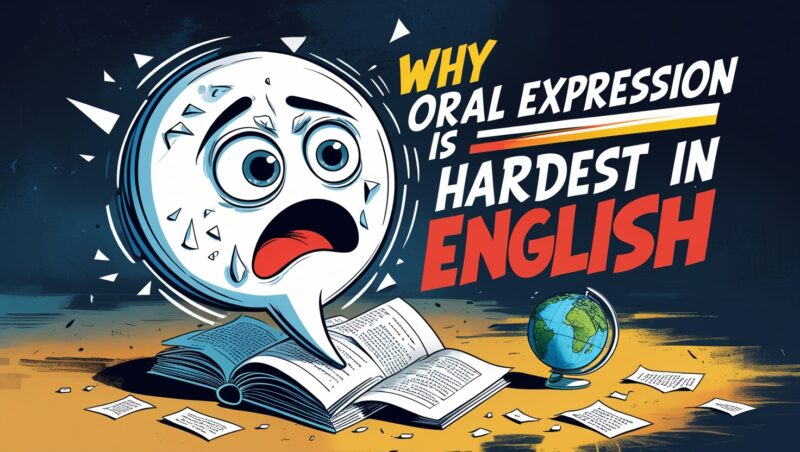Last week, one of my quietest students finally spoke up in class. Just like that—after months of silence. You know what she said? “I didn’t raise my hand before because my heart would beat so fast I thought it would explode.”
That hit me hard. Because after 12 years of teaching English, I’ve seen this same fear paralyze countless students. Let’s talk about why speaking English feels like climbing Mount Everest for so many learners, and what we can actually do about it.
The Reality of Speaking Anxiety
Trust me, I get it. Nothing’s worse than watching your brightest students crumble when it’s time to speak. Just yesterday, Maria—my star writer who crafts essays that could make Shakespeare jealous—couldn’t get through a two-minute presentation without her hands shaking.
Here’s what drives me crazy: we keep treating speaking anxiety like it’s just stage fright. But it’s not. Cambridge research on speaking anxiety shows 67% of English learners rank speaking as their scariest skill, and honestly? That number feels low based on what I see in my classroom.
AI-powered tools are now helping students overcome this invisible barrier by providing a judgment-free environment to practice. Discover how AI tools are transforming speaking confidence here.
The Hidden Monsters Under the Speaking-Skill Bed
Remember playing those video games where you had to jump, shoot, and dodge all at the same time? That’s exactly what speaking English feels like for our students. Except the stakes feel way higher than losing a video game life.
The other day, I asked my advanced class why writing feels easier than speaking. Carlos (usually Mr. Confident himself) blurted out, “Because when I write, time stops. When I speak, it runs away from me.” That’s probably the best explanation I’ve heard in my entire teaching career.
Think about it. When writing, students can:
- Take their sweet time crafting sentences
- Peek at their notes without shame
- Delete mistakes like they never happened
But speaking? It’s like trying to cook a five-course meal while riding a unicycle. In the rain. With an audience watching. Every stumble feels huge, every pause seems eternal, and every mistake echoes in their heads for days.
I’ll tell you something I’ve never shared before in my first year of teaching: I completely misunderstood this challenge. I’d get frustrated when students wouldn’t participate. “Just speak!” I’d think. Now I cringe remembering that. Because understanding why speaking feels impossible for our students is the first step to making it possible.
The Processing Speed Problem: A Brain Traffic Jam
Let me paint you a picture from my classroom last Tuesday. Alex, a student who devours English books like candy, was trying to tell us about his weekend. His face scrunched up, hands gesturing wildly, as words trickled out like molasses. It wasn’t that he didn’t know the words—trust me, this kid’s vocabulary would put some native speakers to shame. But speaking English? That’s a whole different beast.
You know what’s funny? We expect our students to juggle vocabulary, grammar, pronunciation, and cultural norms all at once—and then we wonder why they freeze up. It’s like asking someone to pat their head, rub their stomach, and solve calculus problems while balancing on one foot. In heels. On a moving train.
I used to think my students were overthinking it. Then, I tried teaching my first Chinese class. Suddenly, I was the one stuttering, sweating, and desperately searching for words I KNEW I had learned. That experience changed how I teach forever. Because now I get it—really get it.
Modern fluency assessments recognize the complexity of real-world communication and focus on measuring actual speaking ability, not just isolated skills. Learn how modern fluency assessments are evolving.
Culture Shock in Conversation
Here’s something they never taught me in teacher training: sometimes, the biggest speaking barriers have nothing to do with language. Last semester, I had two students—Yuki from Japan and Sarah from Germany—who perfectly illustrated this.
Sarah would dive into discussions headfirst, interrupting (politely) when she had something to add. Meanwhile, Yuki sat silently, despite knowing every answer. After class one day, she confessed, “In Japan, good students wait their turn. Here, by the time I think it’s my turn, the conversation has moved on.”
That conversation was a wake-up call. I’d been focusing so much on pronunciation drills and vocabulary exercises that I’d completely missed the cultural elephant in the room. It’s not just about knowing the words—it’s about navigating an entirely different way of communicating.
When Practice Makes… More Anxiety?
Okay, confession time: I used to be that teacher who’d say “just practice more!” whenever students struggled with speaking. cringe
But here’s the thing—telling anxious students to practice speaking is like telling someone afraid of heights to just climb more mountains. Without the right approach, practice doesn’t build confidence—it reinforces fear.
I learned this the hard way when my star student, Miguel, stopped coming to class. When I finally caught up with him, he admitted he’d been practicing English for hours at home, recording himself, listening back, and getting more discouraged with every attempt. All that practice was actually making him more self-conscious, not less.
This got me thinking about how we approach speaking practice all wrong. We throw students into conversations without a safety net, then wonder why they’re terrified of falling. It’s time we got smarter about this—and I’ve got some ideas that actually work. (But more on that in a minute.)
The Tech Solution That Changed My Classroom
Look, I’m usually skeptical about edtech. Most of it feels like flashy features wrapped in empty promises. But last semester, I stumbled onto something that actually works. My students started using an AI conversation partner for 10 minutes every morning. No judgment, no pressure, just practice.
At first, I worried it would feel fake or robotic. But here’s what Maria (yes, our nervous presenter from earlier) told me: “It’s like having a patient friend who never gets tired of my mistakes.” That hit home. Sometimes, the best practice partner is one that doesn’t have a human’s impatience.
Creating a Classroom Where Speaking Feels Safe
The most powerful moment in my teaching career happened three weeks ago. Jin—remember her? Our quiet student who was struggling with cultural differences?—suddenly started telling a story about her grandmother. The class was silent, completely hooked. When she finished, she looked surprised at herself, like “Did I just do that?”
Here’s my secret sauce for creating that kind of magic: Start small. Really small. Like “tell your partner what you had for breakfast” small. Build from there.
I’ve torn up my old speaking assessment sheets. They were basically fear generators disguised as evaluation tools. Now we focus on progress, not perfection. And guess what? Students actually speak more when they’re not being graded on every breath.
The Real Game-Changer: Changing Our Mindset
Let me share something embarrassing. For years, I thought being a good speaking teacher meant correcting every error. (I can feel some of you cringing—you’ve been there too, right?)
Then one day, Carlos (our confidence king with secret speaking fears) said something that changed everything: “I don’t need you to fix my English, Miss. I need you to listen to my ideas.”
That’s when it clicked. We’re not teaching speaking—we’re teaching communication. Big difference.
Where Do We Go From Here?
So here’s what I want you to try tomorrow. Just one thing: When a student speaks, fight your teacher instinct to jump in and correct. Instead, listen like you would to a friend telling you a story. React to their ideas, not their errors.
Start there. Build trust. Watch what happens.
Because at the end of the day, this isn’t about perfect pronunciation or textbook grammar. It’s about helping our students find their voice in a new language. And trust me—they’ve got amazing things to say.
I still get messages from former students. The one that touched me most came last week: “Miss, remember how I couldn’t order coffee in English? Yesterday I gave a presentation at work. In English. The whole thing!”
Those moments make all the struggles worth it. But we also know that tracking and measuring this progress systematically can be challenging. That’s exactly why we developed Fluency Flow—to help teachers like you focus on what matters most: building student confidence while having reliable data to support and guide their speaking development.
Our AI-powered platform works alongside your teaching intuition, handling the assessment load so you can concentrate on creating those breakthrough moments we’ve discussed.
Want to see how other teachers are using Fluency Flow to transform their speaking assessment approach? Book a demo with our team, and we’ll show you how to implement these strategies with the support of our technology.
Ready to revolutionize speaking assessment in your classroom? Start your journey with Fluency Flow today. Together, we can help every student find their confident voice in English.




